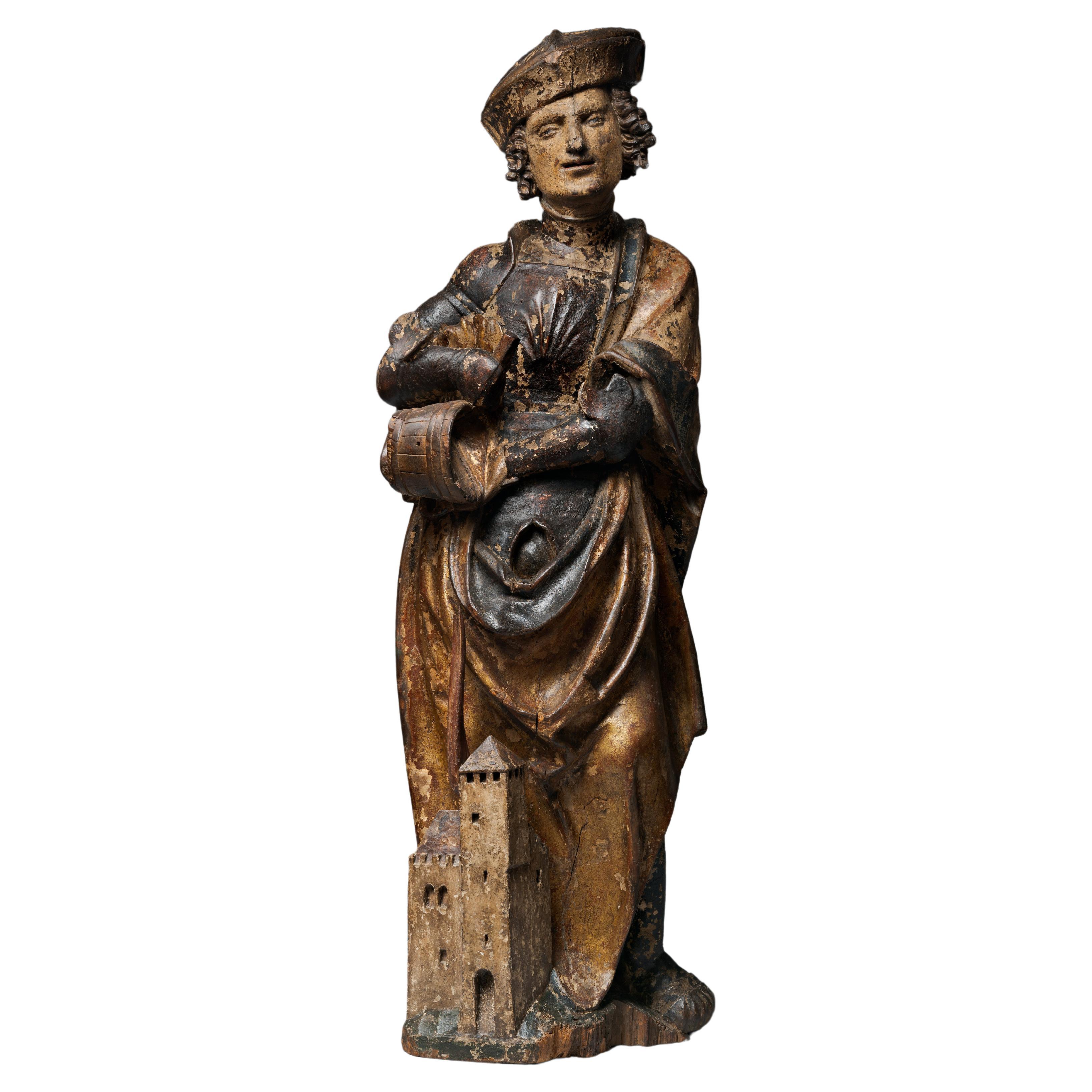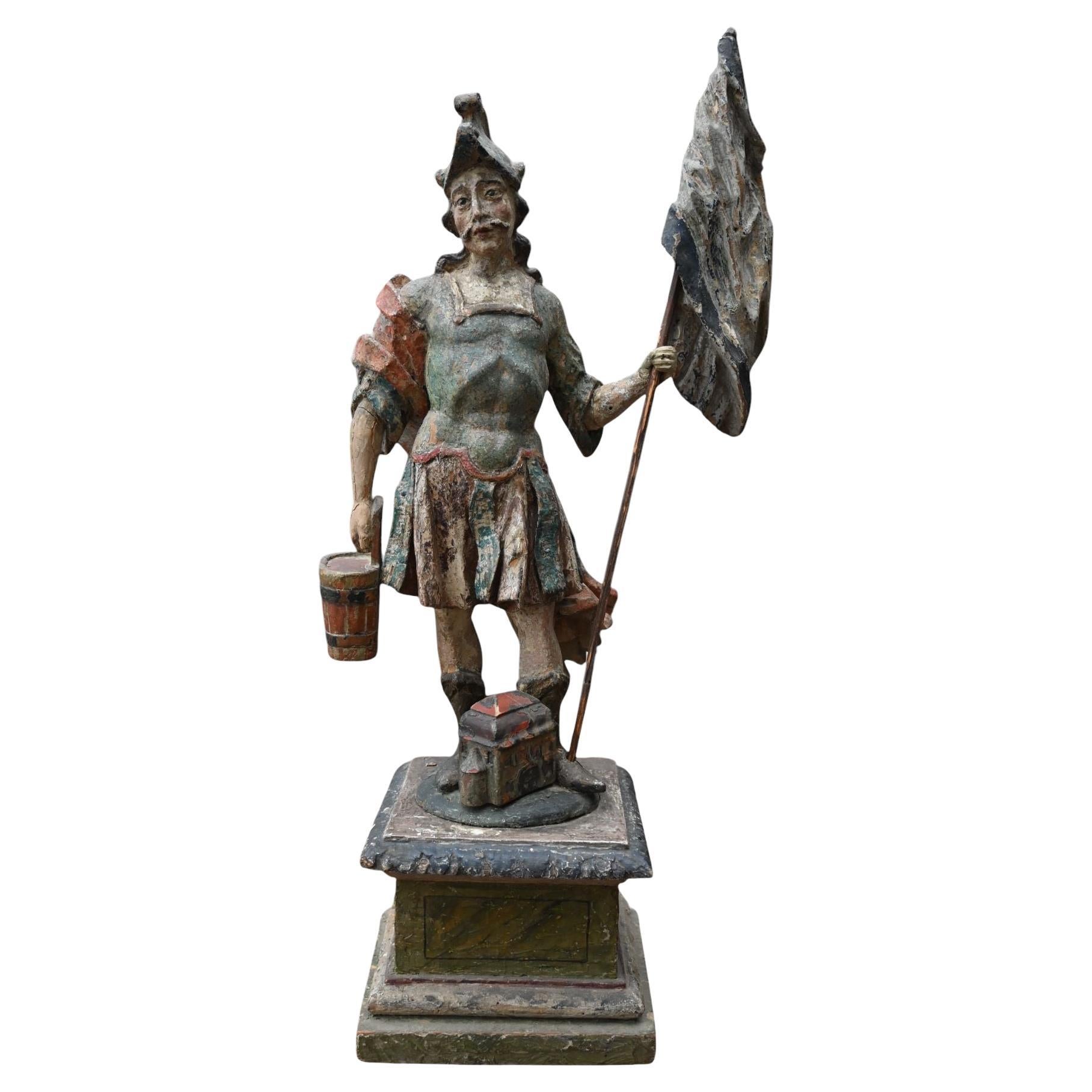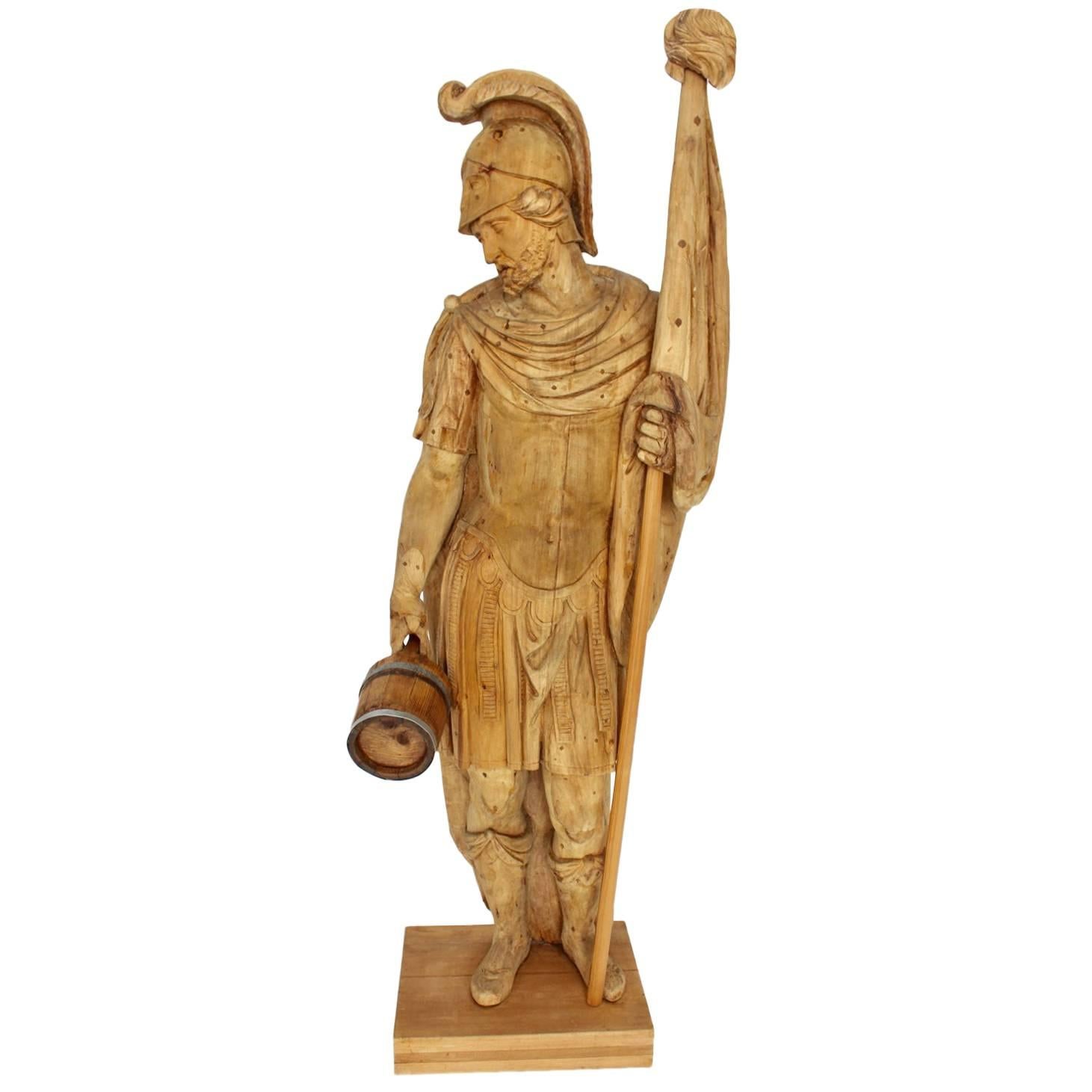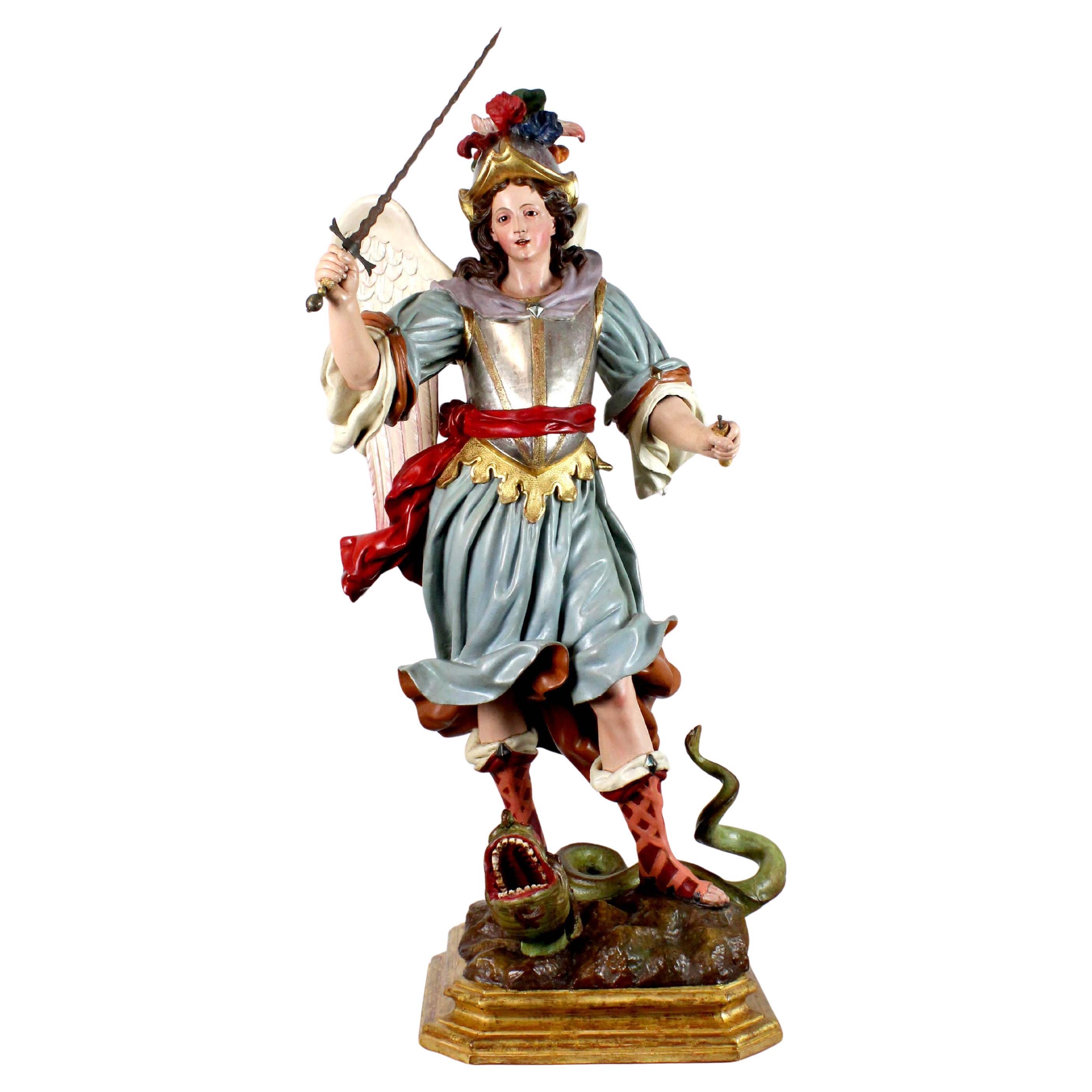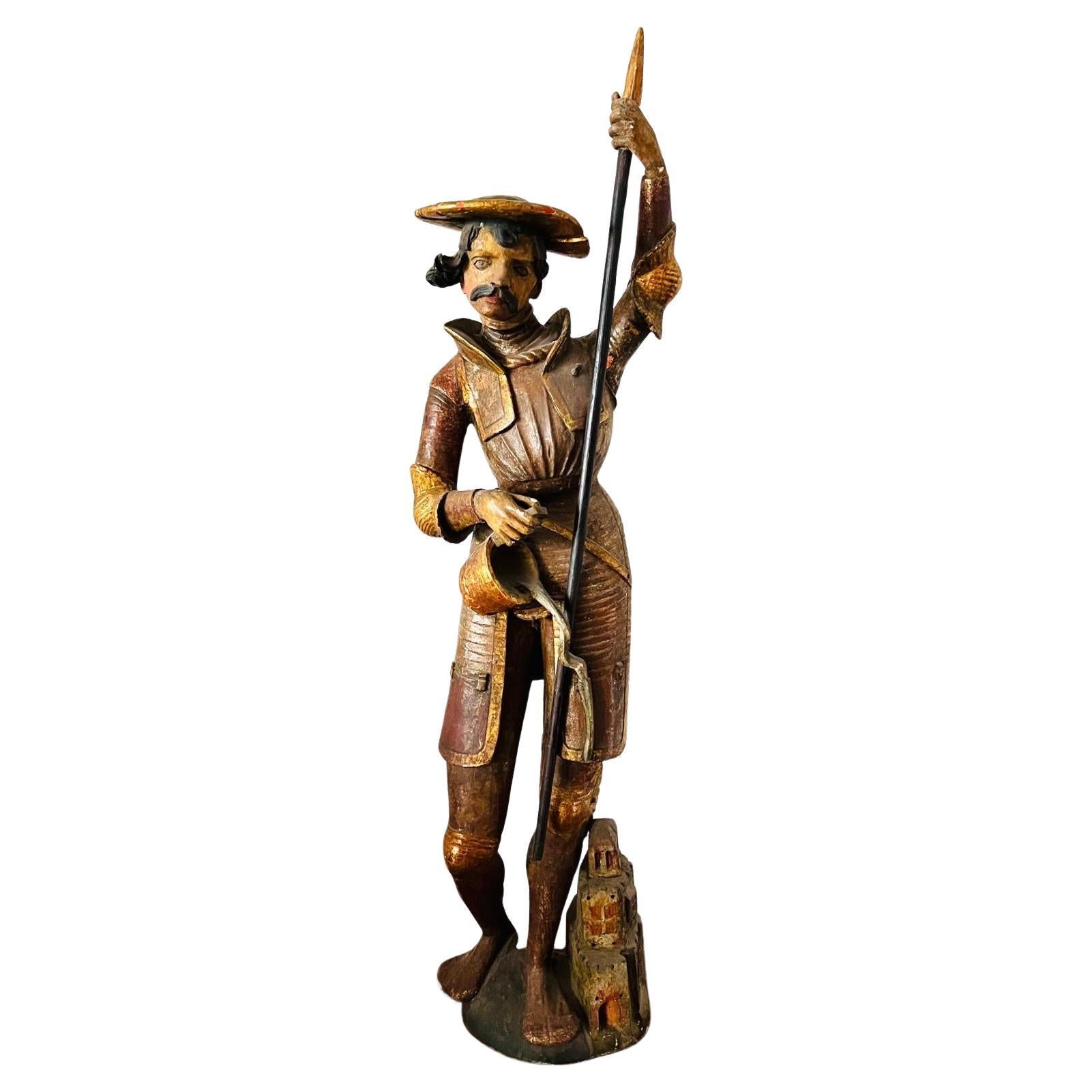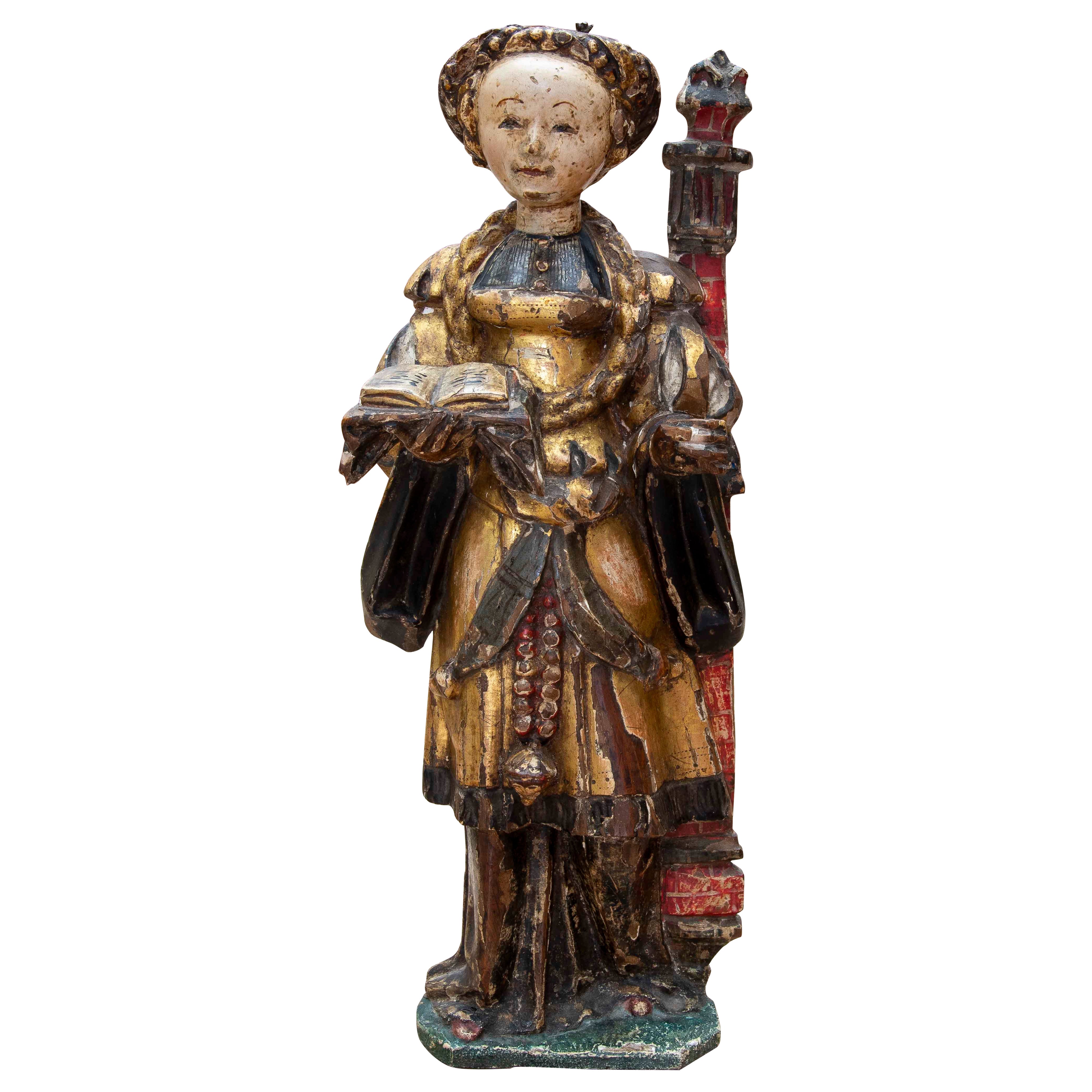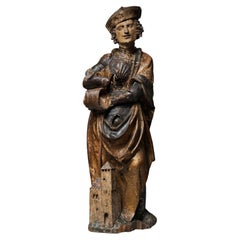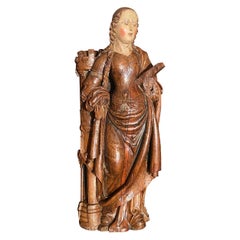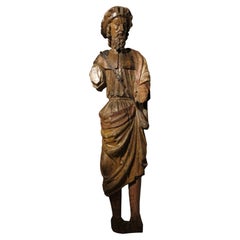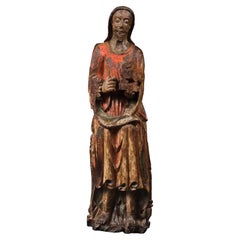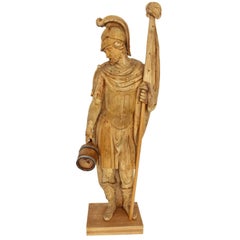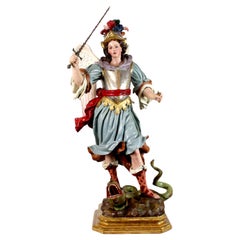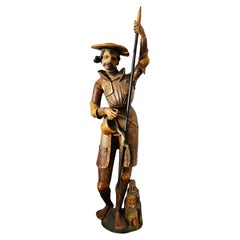Items Similar to Carved Polychrome Wood Depicting Saint Florian
Want more images or videos?
Request additional images or videos from the seller
1 of 5
Carved Polychrome Wood Depicting Saint Florian
$35,633.31
£26,562.18
€30,000
CA$49,667.85
A$53,980.41
CHF 28,526.53
MX$653,046.41
NOK 355,277.66
SEK 335,581.85
DKK 228,463.62
About the Item
CARVED POLYCHROME WOOD DEPICTING SAINT FLORIAN
ORIGIN : SWABIA, SOUTHERN GERMANY
PERIOD : LATE 15th CENTURY
Height : 98 cm
Length : 29 cm
Depth : 24 cm
Polychrome limewood
Very fine condition
Provenance
- Swiss collection STAEHELIN-PARAVICINI - March 1939
- Auction Jacob Hecht -18 April 1929, Berlin
- Sammlung Prof Q.A. LEIMHAAS Munich, Helbing - 26 May 1908
(Research by Thierry Fraslin)
During the Middle-Age Saint Florian was particularly popular, subject to worship in Austria -Tyrol- Bavaria and Bohemia. Embodying courage and commitment Saint Florian was invoked to protect the soul of the living against sins and to keep the soul of the deads from the purgatory.
From the mid-15th century he safeguards from water and fire. The legend has it that when he was young the saint had contained the fire of a burning church with a simple jug of water and had saved a coal merchant from another fire.
This evolution within Saint Florian’s worship is also expressed in arts. For a long time the saint was depicted armoured, holding a sword and victorious over death. From the mid-15th century he is depicted holding a sword and watering a burning house with his jug or bucket of water.
Our sculpture belongs to this second iconographic type. Showing an elongated figure the saint is monoxyle, made from a unique limewood log. The sculpture is almost carved in the round with the back being hollowed out. The original polychromy is well preserved.
The legionary saint, standing, used to hold a bucket of water with which he sprinkled water over a burning house. In his left hand he is holding a spear. The smooth face of the juvenile saint is framed by curly shoulder-length hair.
Saint Florian wears on his shoulders a red and golden cloak over an armour. We can see the breastplate attached to the spaulders. The pieces of armour he wears on his right leg are also depicted with accuaracy.
The face of Saint Florian shows fine features. The semi closed eyelids are topped by eyebrows drown with a simple and precise black line. The gaze is heavy, expressing resignation or melancholy higlighted with a straight and petite mouth.
To the restrained face is opposed the cloak drapery carvings. The cloth is light, agitated and inflated by the wind deniying the material in which it was carved and bringing a realistic air to the sculpture.
This sculpture has to be linked, both because of its iconography and of its style, to the southern Germany production of the late 15th century. Indeed from 1475 to 1530 approximately southern Germany production is marked by a great creativity, becoming a very dynamic center. This art often described as « late gothic » is characterized by softness, restrained sensitivity and by the importance given to details and the drapes virtuosity.
The production was mostly wood carvings, and limewood was the speciality of this region. This wood is tender and light allowing a great freedom for the image carver and a beautiful polish. The sculpture, made of a unique wood log, was worked horizontally thanks to a wheel. We can see the marks of this wheel on the top of Saint Florian’s head. Some elements, more complex or difficult to reach was carved separately and fixed retrospectively to the main sculpture. That was the case for the water bucket of our sculpture. The image carvers often hollowed out the core of the log because when drying it could have caused dangerous cracks. It also participated in making the sculpture lighter.
As expressed by this depiction of Saint Florian, polichromy was a capital part of the making and was never neglicted. The use of gilded paint, typical of late Medieval period, higlight the preciosity of the sculptures. Here the polychromy gives a realistic dimension to the materials depicted as well as enhances his sanctity.
The costume’s details are characteristics of Swabian artists of the late 15th century such as Hans Multscher, active in Ulm between 1430 and 1467. His flourishing workshop influenced the following generations il all Swabia.
The martyr’s costume sharpens the dating. The armour is similar to archduke Sigismond of Tyrol’s exhibited in Vienna’s Kunsthistorisches Museum and dated from 1484. The armour’s style evolves separately from the early 16th century.
Thus, this Saint Florian was made by a talented image carver from a southern Germany’s workshop in the late 15th century.
Hagiography of Saint Florian
If we follow the story of the Passion of Saint Florian, the martyr would have taken place in 304. During those years many soldiers converted to christian faith were persecuted following orders from emperor Diocletian.
After having heard the imprisonment of forty christians in Lauriacum (today Lorch, Austria) Saint Florian went to prefect Aquilinus. He refused to recant his faith despite the prefect’s anger and violence. Aquilinus condemned Florian to be thrown into the Enns river with a heavy stone attached to his neck. When later on his dead body was washed up on the shore he was watched over by an eagle until he was burried by a pious widow named Valery.
On the presumed location of his tomb was erected in 1071 an augustinian convent – Sankt Florian city, 13km away from Linz- rebuild several times over the centuries. Inside the crypt is kept what is believed to be the heavy stone of his martyr. A pilgrimage soon occured.
The spreading of Saint Florian’s relics to Italy and Poland (of which country Saint Florian is the patron saint) allowed his worship to cross Austrian borders. However it is in Austria and southern Germany that his worship was the most significant.
Saint Florian was the first Austrian martyr and the first Austrian saint canonized.
Literature
Claude Lapaire, Sculpture sur bois du Moyen-âge, Genève : Musée d’art et d’histoire, 1986
Coll., Sculpture allemande de la fin du Moyen-âge dans les collections publiques françaises : 1400-1530, Musée du Louvre, 1991
Michael Baxandall, South German Sculpture, 1480-1530, Victoria and Albert Museum, 1974
Sophie Guillot de Suduiraut, Sculptures médiévales allemandes, conservation et restauration, La Documentation française, 1993
Sophie Guillot de Suduiraut, Dévotion et séduction, Sculptures souabes des musées de France vers 1460-1530, Somogy, 2015
- Dimensions:Height: 38.59 in (98 cm)Width: 11.42 in (29 cm)Depth: 9.45 in (24 cm)
- Materials and Techniques:
- Period:
- Date of Manufacture:Late 15th Century
- Condition:Minor fading.
- Seller Location:Saint-Ouen, FR
- Reference Number:Seller: 1301stDibs: LU3115336024812
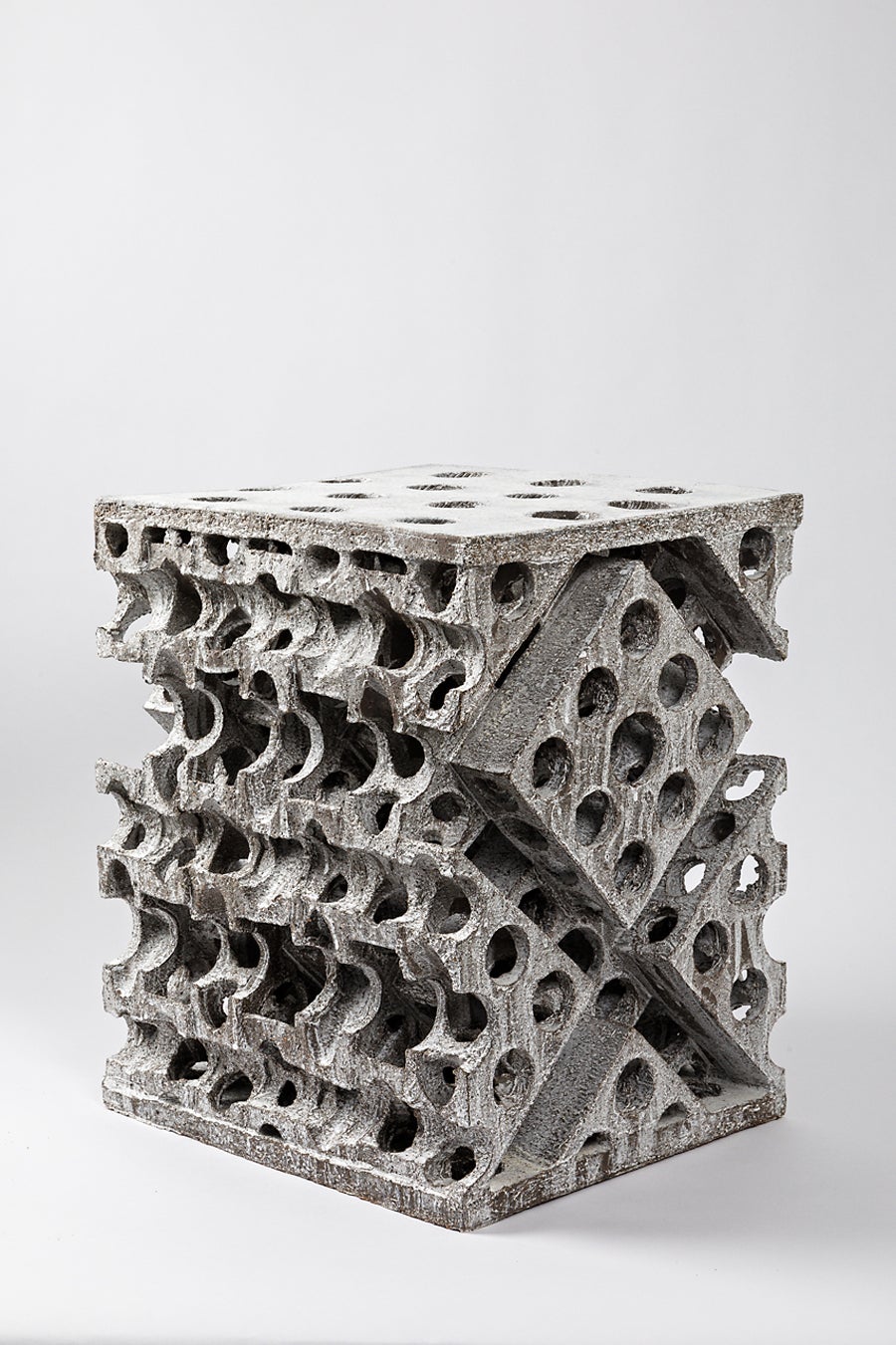
About the Seller
5.0
Vetted Professional Seller
Every seller passes strict standards for authenticity and reliability
Established in 2016
1stDibs seller since 2017
200 sales on 1stDibs
Typical response time: 3 hours
- ShippingRetrieving quote...Shipping from: Paris, France
- Return Policy
Authenticity Guarantee
In the unlikely event there’s an issue with an item’s authenticity, contact us within 1 year for a full refund. DetailsMoney-Back Guarantee
If your item is not as described, is damaged in transit, or does not arrive, contact us within 7 days for a full refund. Details24-Hour Cancellation
You have a 24-hour grace period in which to reconsider your purchase, with no questions asked.Vetted Professional Sellers
Our world-class sellers must adhere to strict standards for service and quality, maintaining the integrity of our listings.Price-Match Guarantee
If you find that a seller listed the same item for a lower price elsewhere, we’ll match it.Trusted Global Delivery
Our best-in-class carrier network provides specialized shipping options worldwide, including custom delivery.More From This Seller
View AllSaint Florian
Located in Saint-Ouen, FR
SAINT FLORIAN
ORIGIN: SOUTH GERMANY, SWABIA
PERIOD: END OF THE 15th CENTURY
Height : 100,5 cm
Width : 34 cm
Depth : 17 cm
Polychromed lime wood
Good state of conservation
Sin...
Category
Antique 15th Century and Earlier German Gothic Figurative Sculptures
Materials
Wood
$49,886
Important Sculpture Representing Saint Barbara
Located in Saint-Ouen, FR
IMPORTANT WOOD SCULPTURE REPRESENTING SAINT BARBARA
ORIGIN : NORTHERN FRANCE OR FLANDERS
PERIOD : 16th CENTURY
Height: 103 cm
Length: 40 cm
Depth: 30 cm
Oak wood
Good condition
Saint Barbara was the daughter of Dioscorus who imprisonned her in a tower to prevent her from being corrupted by Christianity. Despite this, she was taught and baptisted by a local priest. According to legend, she proved her faith by carving a third window into the tower, symbolic of the Trinity.
Once her father learned this, he threatened her with his sword. She managed to escape and hide, not before being revealed by a sheperd. She was thrown in jail and tortured, refusing to denounce her faith. Her father forced her up to the mountain’s summit and decapitated her, afterwhich God struck him down by lightning.
Saint Barbara`s following was popularized in the Occident in the 13th century because of the Golden Legend...
Category
Antique 16th Century Figurative Sculptures
Materials
Oak
15th Century Carved Wood Depicting Saint James
Located in Saint-Ouen, FR
The Saint depicted here is Saint James the Great.
James is the brother of St. John the Evangelist. Nothing is known of his activities after the Ascension...
Category
Antique 15th Century and Earlier French Gothic Figurative Sculptures
Materials
Oak
Wood Sculpture Depicting John the Baptist
Located in Saint-Ouen, FR
This wood scultpure showing fine traces of polychromy depicts John the Baptist, one the Old Testament’s last prophets and the first martyr of the New Testament. He is easily recognizable with the lamb he is carrying in his left hand. The way the artist has carved the face exudes a spiritual strenght inherited from previous centuries.
Description
Saint John the Baptist is depicted bare feet, seated in a hieratic manner. His elongated face is marked by a beard and a moustache. The straight nose and wide eyes indicate a Spanish origin. This asumption is reaffirmed by the Saint’s resigned expression.
His parted hair frames his face while uncovering his ears.
He wears a round collar red-orange tunic, draped onto the body and belted at the waist. A flap of his green coat covers his knees and falls down in stylized pleats.
Following iconographic rules Saint John the Baptist is pointing with his right hand the lamb seated...
Category
Antique 15th Century and Earlier Spanish Gothic Figurative Sculptures
Materials
Wood
Carved Wood Depicting Saint Martin
Located in Saint-Ouen, FR
Carved wood depicting saint martin
Origin : Germany
Period : 15th century
Measure: Height : 85 cm
Wood
Polychrome remains
Good state of conservation
Collection number on the back 26757
Our partially polychromed Saint...
Category
Antique 15th Century and Earlier Figurative Sculptures
Materials
Wood
Important Wood Sculpture, Gothic Depiction of Saint Wenceslaus
Located in Saint-Ouen, FR
IMPORTANT WOOD SCULPTURE, GOTHIC DEPICTION OF SAINT WENCESLAUS
ORIGIN : CENTRAL EUROPE
PERIOD : MID-15th CENTURY
Height : 83 cm
Length : 30 cm
Depth : 20 cm
Basswood
Good condit...
Category
Antique 15th Century and Earlier Figurative Sculptures
Materials
Wood
You May Also Like
17th Century Italian Polychrome Carved Wood Statue Of Saint Florian
Located in Bilzen, BE
A fine quality 17th century Italian polychrome carved wood Saint Florian Saint Florian (Latin: Florianus; 250 – c. 304 AD) was a Christian holy man a...
Category
Antique 17th Century Italian Baroque Sculptures and Carvings
Materials
Wood
Wooden Folk Art Huge Hand Carved Figure Saint Florian, 18th Century, Austria
Located in Vienna, AT
This huge hand-carved figure shows the protector and patron against fire, Saint Florian.
St. Florian is dressed like a roman soldier and his attribute is a water bucket.
The figure w...
Category
Antique Late 18th Century Austrian Religious Items
Materials
Wood
Saint Michael the Archangel, polychrome carved wood, attributed to L.S. Carmona
Located in Madrid, España
A polychrome carved wooden statue of St. Michael the Archangel. It's believed to be the work of Luis Salvador Carmona (Nava del Rey, Valladolid, 15 November 1708 – Madrid, 4 Februar...
Category
Antique Mid-18th Century Spanish Baroque Figurative Sculptures
Materials
Wood
16th C. Polychromed Carved St. Florian, Former N. Rothschild Collection
Located in Doha, QA
From the esteemed former collection of Baron Nathaniel de Rothschild, this exquisite early 16th-century polychromed carved wood figure of St. Florian stands as a rare example of late...
Category
Antique 16th Century German Gothic Figurative Sculptures
Materials
Wood, Giltwood
15th Polychrome Wooden Sculpture of Saint Barbara. Mechelen.
Located in Marbella, ES
This sculpture represents the maiden of Nicomedia kept in a tower with three windows where her father locked her away. In her right hand she holds an open book that records her medit...
Category
Antique 15th Century and Earlier Belgian Figurative Sculptures
Materials
Gold
Renaissance Italian sculptor - 16th century carved wood sculpture - Saint Robert
Located in Varmo, IT
Carved wooden sculpture - Saint Robert. Italy, 16th century.
54 x 30 x h 112 cm.
Entirely carved and painted wood with traces of polychrome and gilding.
- Inscribed on the base: "...
Category
16th Century Renaissance Figurative Sculptures
Materials
Wood
$3,563 Sale Price
25% Off
More Ways To Browse
Verlys France
15th Century Polychrome Sculpture
Francaise Collection
Limewood Sculpture
Austrian Cross
Saint Florian
Antique Passports
Art Deco Lighted Sculptures
Bather Sculpture
Bronze Female Torso
Bronze Swords
Brutalist Sculpture Figure
Chinese Marble Sculpture
Cylindrical Plinth
David Goliath
Female Warrior
French 18th Century Wood Angel
Harlequin Italy
